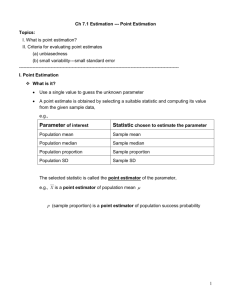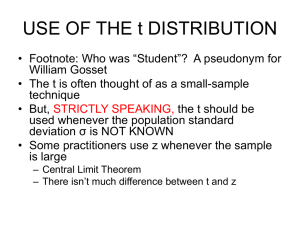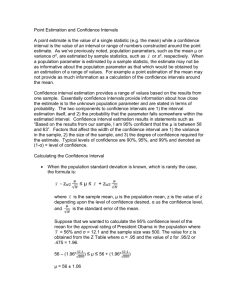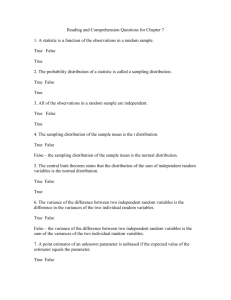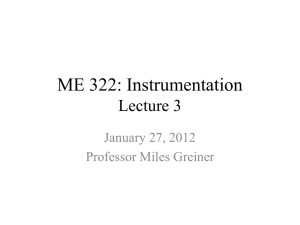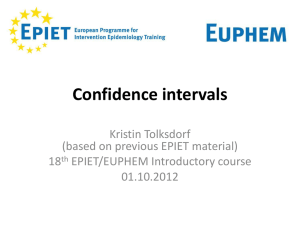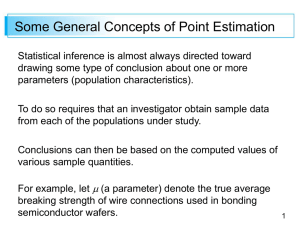Chapter 8: Estimation
advertisement
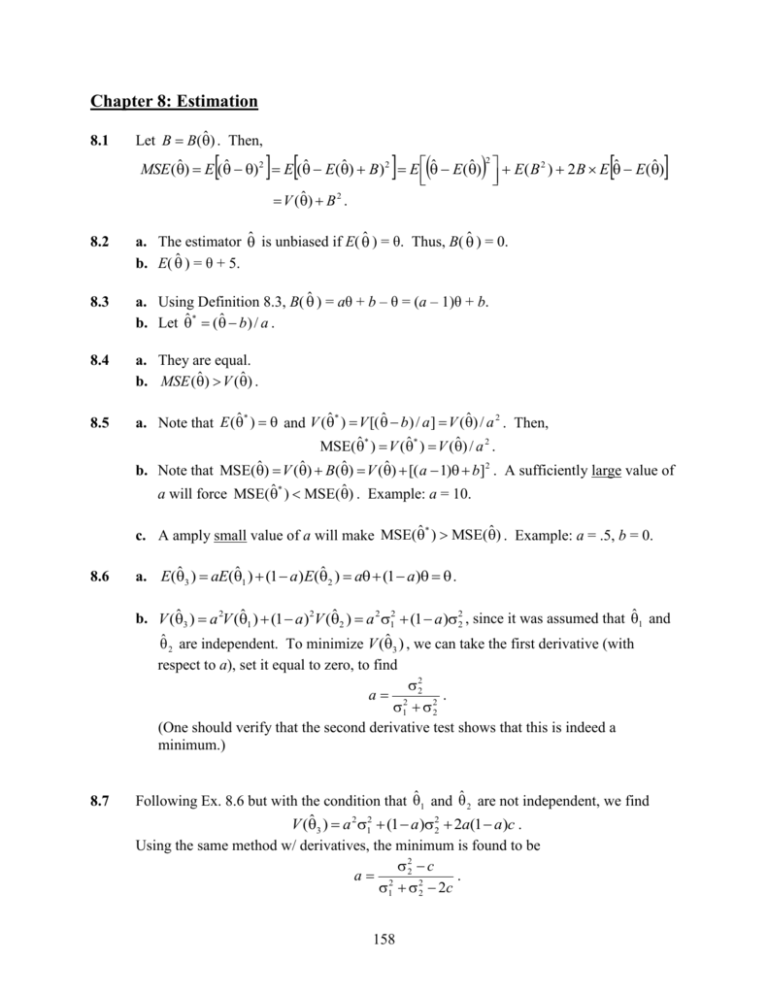
Chapter 8: Estimation 8.1 Let B B(ˆ ) . Then, 2 MSE (ˆ ) E (ˆ ) 2 E (ˆ E(ˆ ) B) 2 E ˆ E(ˆ ) E( B 2 ) 2 B E ˆ E(ˆ ) 2 V (ˆ ) B . 8.2 a. The estimator ̂ is unbiased if E( ̂ ) = θ. Thus, B( ̂ ) = 0. b. E( ̂ ) = θ + 5. 8.3 a. Using Definition 8.3, B( ̂ ) = aθ + b – θ = (a – 1)θ + b. b. Let ˆ * (ˆ b ) / a . 8.4 a. They are equal. b. MSE (ˆ ) V (ˆ ) . 8.5 a. Note that E ( ˆ * ) and V (ˆ * ) V [( ˆ b ) / a ] V (ˆ ) / a 2 . Then, MSE(ˆ * ) V (ˆ * ) V (ˆ ) / a 2 . b. Note that MSE(ˆ ) V (ˆ ) B(ˆ ) V (ˆ ) [( a 1) b]2 . A sufficiently large value of a will force MSE(ˆ * ) MSE(ˆ ) . Example: a = 10. c. A amply small value of a will make MSE(ˆ * ) MSE(ˆ ) . Example: a = .5, b = 0. 8.6 a. E(ˆ 3 ) aE(ˆ 1 ) (1 a )E(ˆ 2 ) a (1 a ) . b. V (ˆ 3 ) a 2V (ˆ 1 ) (1 a ) 2V (ˆ 2 ) a 2 12 (1 a ) 22 , since it was assumed that ̂1 and ̂ are independent. To minimize V (ˆ ) , we can take the first derivative (with 2 3 respect to a), set it equal to zero, to find 22 . 12 22 (One should verify that the second derivative test shows that this is indeed a minimum.) a 8.7 Following Ex. 8.6 but with the condition that ̂1 and ̂ 2 are not independent, we find V (ˆ ) a 2 2 (1 a )2 2a(1 a )c . 3 1 2 Using the same method w/ derivatives, the minimum is found to be 2 c a 2 2 2 . 1 2 2c 158 Chapter 8: Estimation 159 Instructor’s Solutions Manual 8.8 a. Note that ̂1 , ̂ 2 , ̂ 3 and ̂ 5 are simple linear combinations of Y1, Y2, and Y3. So, it is easily shown that all four of these estimators are unbiased. From Ex. 6.81 it was shown that ̂ 4 has an exponential distribution with mean θ/3, so this estimator is biased. b. It is easily shown that V( ̂1 ) = θ2, V( ̂ 2 ) = θ2/2, V( ̂ 3 ) = 5θ2/9, and V( ̂ 5 ) = θ2/9, so the estimator ̂ 5 is unbiased and has the smallest variance. 8.9 The density is in the form of the exponential with mean θ + 1. We know that Y is unbiased for the mean θ + 1, so an unbiased estimator for θ is simply Y – 1. 8.10 a. For the Poisson distribution, E(Y) = λ and so for the random sample, E( Y ) = λ. Thus, the estimator ̂ Y is unbiased. b. The result follows from E(Y) = λ and E(Y2) = V(Y) + λ2 = 2λ2, so E(C) = 4λ + λ2. c. Since E( Y ) = λ and E( Y 2 ) = V( Y ) + [E( Y )]2 = λ2/n + λ2 = 2 (1 1 / n) . Then, we can construct an unbiased estimator ˆ Y 2 Y (4 1 / n ) . 8.11 The third central moment is defined as E[(Y )3 ] E[(Y 3)3 ] E(Y 3 ) 9E(Y 2 ) 54 . Using the unbiased estimates ̂ 2 and ̂ 3 , it can easily be shown that ̂ 3 – 9 ̂ 2 + 54 is an unbiased estimator. 8.12 a. For the uniform distribution given here, E(Yi) = θ + .5. Hence, E( Y ) = θ + .5 so that B( Y ) = .5. b. Based on Y , the unbiased estimator is Y – .5. c. Note that V (Y ) 1 /(12n) so MSE(Y ) 1 /(12n) .25 . 8.13 a. For a random variable Y with the binomial distribution, E(Y) = np and V(Y) = npq, so E(Y2) = npq + (np)2. Thus, EnYn 1 Yn E (Y ) 1n E (Y 2 ) np pq np 2 ( n 1) pq . b. The unbiased estimator should have expected value npq, so consider the estimator ˆ nn1 nYn 1 Yn . 8.14 Using standard techniques, it can be shown that E(Y) = 1 , E(Y2) = 2 2 . Also, it is easily shown that Y(n) follows the power family with parameters nα and θ. 160 Chapter 8: Estimation Instructor’s Solutions Manual a. From the above, E (ˆ ) E (Y( n ) ) nn1 , so that the estimator is biased. b. Since α is known, the unbiased estimator is n1 ˆ n1 Y . n n (n) c. MSE (Y( n ) ) E[(Y( n ) ) 2 ] E(Y(2n ) ) 2E(Y( n ) ) 2 ( n1)(2n2) 2 . 8.15 Using standard techniques, it can be shown that E(Y) =(3/2)β, E(Y2) = 3β2. Also it is easiliy shown that Y(1) follows the Pareto family with density function g (1) ( y ) 3n3n y ( 3n1) , y ≥ β. Thus, E(Y(1)) = 33nn1 and E(Y(12) ) 3n3n 2 2 . a. With ˆ Y(1) , B(ˆ ) 33nn1 3n11 . b. Using the above, MSE (ˆ ) MSE (Y(1) ) E(Y(12) ) 2E(Y(1) ) 2 ( 3n1)(23n2 ) 2 . 8.16 It is known that ( n 1)S 2 / 2 is chi–square with n–1 degrees of freedom. a. E( S ) E ( n 1) S 2 n 1 2 1/ 2 n 1 v 1/ 2 1 [( n 1) / 2 ]2( n 1 ) / 2 v ( n1) / 2 e v / 2 dv 2 ( n / 2 ) n 1 [( n 1) / 2 ] . 0 b. The estimator ˆ n 1[( n 1) / 2 ] 2 ( n / 2 ) S is unbiased for σ. c. Since E( Y ) = μ, the unbiased estimator of the quantity is Y z ˆ . 8.17 It is given that p̂1 is unbiased, and since E(Y) = np, E( p̂2 ) = (np + 1)/(n+2). a. B( p̂2 ) = (np + 1)/(n+2) – p = (1–2p)/(n+2). b. Since p̂1 is unbiased, MSE( p̂1 ) = V( p̂1 ) = p(1–p)/n. MSE( p̂2 ) = V( p̂2 ) + B( p̂2 ) = np(1 p )(1 2 p )2 ( n 2 )2 . c. Considering the inequality np(1 p )(1 2 p )2 ( n 2 )2 p (1 p ) n , this can be written as (8n 4) p 2 (8n 4) p n 0 . Solving for p using the quadratic formula, we have p 8 n 4 ( 8 n 4 )2 4 ( 8 n 4 ) n 2( 8 n 4 ) 12 n 1 8n4 . So, p will be close to .5. 8.18 Using standard techniques from Chapter 6, is can be shown that the density function for Y(1) is given by g (1) ( y ) n 1 So, E(Y(1)) = 8.19 n 1 y n 1 , 0 ≤ y ≤ θ. and so an unbiased estimator for θ is (n+1)Y(1). From the hint, we know that E(Y(1)) = β/n so that ̂ = nY(1) is unbiased for β. Then, MSE( ̂ ) = V( ̂ ) + B( ̂ ) = V(nY(1)) = n2V(Y(1)) = β2. Chapter 8: Estimation 161 Instructor’s Solutions Manual 8.20 If Y has an exponential distribution with mean θ, then by Ex. 4.11, E ( Y ) / 2 . a. Since Y1 and Y2 are independent, E(X) = πθ/4 so that (4/π)X is unbiased for θ. b. Following part a, it is easily seen that E(W) = π2θ2/16, so (42/π2)W is unbiased for θ2. 8.21 Using Table 8.1, we can estimate the population mean by y = 11.5 and use a two– standard–error bound of 2(3.5)/ 50 = .99. Thus, we have 11.5 ± .99. 8.22 (Similar to Ex. 8.21) The point estimate is y = 7.2% and a bound on the error of estimation is 2(5.6)/ 200 = .79%. 8.23 a. The point estimate is y = 11.3 ppm and an error bound is 2(16.6)/ 467 = 1.54 ppm. b. The point estimate is 46.4 – 45.1 = 1.3 and an error bound is 2 c. The point estimate is .78 – .61 = .17 and an error bound is 2 ( 9.8 )2 191 (.78)(.22) 467 (10.2 )2 467 = 1.7. )(.39) = .08. (.61191 8.24 )(.31) Note that by using a two–standard–error bound, 2 (.691001 = .0292 ≈ .03. Constructing this as an interval, this is (.66, .72). We can say that there is little doubt that the true (population) proportion falls in this interval. Note that the value 50% is far from the interval, so it is clear that a majority did feel that the cost of gasoline was a problem. 8.25 We estimate the difference to be 2.4 – 3.1 = –.7 with an error bound of 2 8.26 a. The estimate of the true population proportion who think humans should be sent to Mars is .49 with an error bound of 2 .49(.51) 1093 1.44 2.64 100 = .404. = .03. b. The standard error is given by pˆ (1n pˆ ) , and this is maximized when p̂ = .5. So, a conservative error bound that could be used for all sample proportions (with n = 1093) is 2 8.27 .5(.5) 1093 = .0302 (or 3% as in the above). a. The estimate of p is the sample proportion: 592/985 = .601, and an error bound is given by 2 .601(.399) 985 = .031. b. The above can be expressed as the interval (.570, .632). Since this represents a clear majority for the candidate, it appears certain that the republican will be elected. Following Example 8.2, we can be reasonably confident by this statement. c. The group of “likely voters” is not necessarily the same as “definite voters.” 8.28 The point estimate is given by the difference of the sample proportions: .70 – .54 = .16 and an error bound is 2 .7(.3) 180 (.46 ) = .121. .54100 162 Chapter 8: Estimation Instructor’s Solutions Manual 8.29 a. The point estimate is the difference of the sample proportions: .45 – .51 = –.06, and an error bound is 2 .45(.55) 1001 = .045. .51(.49) 1001 b. The above can be expressed as the interval (–.06 – .045, –.06 + .045) or (–.105, –.015). Since the value 0 is not contained in the interval, it seems reasonable to claim that fan support for baseball is greater at the end of the season. 8.30 (.55) The point estimate is .45 and an error bound is 2 .451001 = .031. Since 10% is roughly three times the two–standard–error bound, it is not likely (assuming the sample was indeed a randomly selected sample). 8.31 a. The point estimate is the difference of the sample proportions: .93 – .96 = –.03, and an error bound is 2 .93(.07) 200 = .041. .96(.04) 450 b. The above can be expressed as the interval (–.071, .011). Note that the value zero is contained in the interval, so there is reason to believe that the two pain relievers offer the same relief potential. 8.32 With n = 20, the sample mean amount y = 197.1 and the standard deviation s = 90.86. The total accounts receivable is estimated to be 500( y ) = 500(197.1) = 98,550. The standard deviation of this estimate is found by V (500Y ) 500 20 . So, this can be estimated by 500(90.86)/ 20 = 10158.45 and an error bound is given by 2(10158.46) = 20316.9. 8.33 8.34 With y = 197.1, an error bound is 2(90.86)/ 20 = 40.63. Expressed as an interval, this is (197.1 – 40.63, 197.1 + 40.63) or (156.47, 237.73). So, it is unlikely that the average amount exceeds $250. (.7 ) The point estimate is 6/20 = .3 and an error bound is 2 .320 = .205. If 80% comply, and 20% fail to comply. This value lies within our error bound of the point estimate, so it is likely. An unbiased estimator of λ is Y , and since V (Y ) / n , an unbiased estimator of the standard error of is 8.35 Y /n . Using the result of Ex. 8.34: a. The point estimate is y = 20 and a bound on the error of estimation is 2 20 / 50 = 1.265. b. The point estimate is the difference of the sample mean: 20 – 23 = –3. Chapter 8: Estimation 163 Instructor’s Solutions Manual 8.36 An unbiased estimator of θ is Y , and since V (Y ) / n , an unbiased estimator of the standard error of is Y / n . 8.37 Refer to Ex. 8.36: with n = 10, an estimate of θ = y = 1020 and an error bound is 2 1000 / 10 = 645.1. 8.38 To find an unbiased estimator of V (Y ) estimator of 1 p 1 p2 . Further, E (Y 2 ) V (Y ) [ E (Y )] 2 Therefore, an unbiased estimate of V(Y) is 8.39 1p , note that E(Y) = Y 2 Y 2 2 p2 1 p 1 p so Y is an unbiased so E (Y 2 Y ) 2 p2 . Y Y 2Y . 2 Using Table 6 with 4 degrees of freedom, P.71072 2Y / 9.48773 = .90. So, 2Y 2Y = .90 P9.48773 .71072 2Y 2Y forms a 90% CI for β. and 9.48773 , .71072 8.40 Use the fact that Z Y has a standard normal distribution. With σ = 1: a. The 95% CI is (Y – 1.96, Y + 1.96) since P( 1.96 Y 1.96) P(Y 1.96 Y 1.96) .95 . b. The value Y + 1.645 is the 95% upper limit for μ since P(Y 1.645) P( Y 1.645) .95 . c. Similarly, Y – 1.645 is the 95% lower limit for μ. 8.41 Using Table 6 with 1 degree of freedom: a. .95 P(.0009821 Y 2 / 2 5.02389 ) P(Y 2 / 5.02389 2 Y 2 / .0009821) . b. .95 P(.0039321 Y 2 / 2 ) P( 2 Y 2 / .0039321) . c. .95 P(Y 2 / 2 3.84146 ) P(Y 2 / 3.84146 2 ) . 8.42 Using the results from Ex. 8.41, the square–roots of the boundaries can be taken to obtain interval estimates σ: a. Y/2.24 ≤ σ ≤ Y/.0313. b. σ ≤ Y/.0627. c. σ ≥ Y/1.96. 8.43 a. The distribution function for Y(n) is Gn ( y ) for U is given by , 0 ≤ y ≤ θ, so the distribution function y n FU (u ) P(U u ) P(Y( n ) u ) Gn (u ) u, 0 ≤ y ≤ 1. Y( n) b. (Similar to Example 8.5) We require the value a such that P a = FU(a) = .95. n 1/n Therefore, a = .95 so that a = (.95) and the lower confidence bound is [Y(n)](.95)–1/n. 164 Chapter 8: Estimation Instructor’s Solutions Manual 2( t ) 2y y2 , 0 < y < θ. dt 2 2 0 y 8.44 a. FY ( y ) P(Y y ) b. The distribution of U = Y/θ is given by FU (u ) P(U u ) P(Y u ) FY (u ) 2u u 2 2u(1 u ) , 0 < u < 1. Since this distribution does not depend on θ, U = Y/θ is a pivotal quantity. c. Set P(U ≤ a) = FY(a) = 2a(1 – a) = .9 so that the quadratic expression is solved at a = 1 – .10 = .6838 and then the 90% lower bound for θ is Y/.6838. 8.45 Following Ex. 8.44, set P(U ≥ b) = 1 – FY(b) = 1 – 2b(1 – b) = .9, thus b = 1 – .05132 and then the 90% upper bound for θ is Y/.05132. 8.46 Let U = 2Y/θ and let mY(t) denote the mgf for the exponential distribution with mean θ. Then: a. mU (t ) E ( e tU ) E ( e t 2Y / ) mY ( 2t / ) (1 2t ) 1 . This is the mgf for the chi–square distribution with one degree of freedom. Thus, U has this distribution, and since the distribution does not depend on θ, U is a pivotal quantity. .9 = b. Using Table 6 with 2 degrees of freedom, we have P.102587 2Y / 5.99147 .90 . 2Y 2Y So, 5.99147 , .102587 represents a 90% CI for θ. c. They are equivalent. 8.47 Note that for all i, the mgf for Yi is mY (t ) (1 t ) 1 , t < 1/θ. a. Let U 2i 1Yi / . The mgf for U is n mU (t ) E(etU ) mY (2t / ) (1 2t ) n , t 1/ 2 . This is the mgf for the chi–square distribution with 2n degrees of freedom. Thus, U has this distribution, and since the distribution does not depend on θ, U is a pivotal quantity. n b. Similar to part b in Ex. 8.46, let .2975 , .2025 be percentage points from the chi–square distribution with 2n degrees of freedom such that P .2975 2i 1Yi / .2025 .95 . 2n Yi 2n Yi i 1 i 1 , So, 2 2 .025 .975 n represents a 95% CI for θ. 2(7)( 4.77) 2(7)( 4.77) , c. The CI is or (2.557, 11.864). 26.1190 5.62872 Chapter 8: Estimation 165 Instructor’s Solutions Manual 8.48 (Similar to Ex. 8.47) Note that for all i, the mgf for Yi is mY (t ) (1 ) 2 , t < 1/β. a. Let U 2i 1Yi / . The mgf for U is n mU (t ) E(etU ) mY (2t / ) (1 2t ) 2n , t 1/ 2 . This is the mgf for the chi–square distribution with 4n degrees of freedom. Thus, U has this distribution, and since the distribution does not depend on θ, U is a pivotal quantity. n b. Similar to part b in Ex. 8.46, let .2975 , .2025 be percentage points from the chi–square distribution with 4n degrees of freedom such that P .2975 2i 1Yi / .2025 .95 . 2n Yi 2n Yi i 1 i 1 , So, 2 2 .025 .975 n represents a 95% CI for β. 2(5)(5.39 ) 2(5)(5.39 ) , c. The CI is or (1.577, 5.620). 34.1696 9.59083 8.49 a. If α = m (a known integer), then U = 2i 1Yi / still a pivotal quantity and using a n mgf approach it can be shown that U has a chi–square distribution with mn degrees of freedom. So, the interval is 2n Yi 2n Yi i 1 , 2i 1 , 2 / 2 1 / 2 2 2 where 1 / 2 , / 2 are percentage points from the chi–square distribution with mn degrees of freedom. b. The quantity U = n Y / is distributed as gamma with shape parameter cn and scale i 1 i parameter 1. Since c is known, percentiles from this distribution can be calculated from this gamma distribution (denote these as 1 / 2 , / 2 ) so that similar to part a, the CI is n Yi n Yi i 1 , i 1 . 2 / 2 1 / 2 c. Following the notation in part b above, we generate the percentiles using the Applet: .975 16.74205, .025 36.54688 10(11.36 ) 10(11.36 ) , Thus, the CI is or (3.108, 6.785). 36.54688 16.74205 166 Chapter 8: Estimation Instructor’s Solutions Manual 8.50 a. –.1451 b. .2251 c. Brand A has the larger proportion of failures, 22.51% greater than Brand B. d. Brand B has the larger proportion of failures, 14.51% greater than Brand A. e. There is no evidence that the brands have different proportions of failures, since we are not confident that the brand difference is strictly positive or negative. 8.51 a.-f. Answers vary. 8.52 a.-c. Answers vary. d. The proportion of intervals that capture p should be close to .95 (the confidence level). 8.53 a. i. Answers vary. b. Answers vary. 8.54 a. The interval is not calculated because the length is zero (the standard error is zero). b.-d. Answers vary. e. The sample size is not large (consider the validity of the normal approximation to the binomial). 8.55 Answers vary, but with this sample size, a normal approximation is appropriate. 8.56 8.57 8.58 8.59 8.60 ii. smaller confidence level, larger sample size, smaller value of p. (.55) a. With z.01 = 2.326, the 98% CI is .45 2.326 .45800 or .45 ± .041. b. Since the value .50 is not contained in the interval, there is not compelling evidence that a majority of adults feel that movies are getting better. (.49) With z.005 = 2.576, the 99% interval is .51 2.576 .511001 or .51 ± .04. We are 99% confident that between 47% and 55% of adults in November, 2003 are baseball fans. The parameter of interest is μ = mean number of days required for treatment. The 95% CI is approximately y z.025 s / n , or 5.4 ± 1.96(3.1 / 500 ) or (5.13, 5.67). (.22) a. With z.05 = 1.645, the 90% interval is .78 1.645 .781030 or .78 ± .021. b. The lower endpoint of the interval is .78 – .021 = .759, so there is evidence that the true proportion is greater than 75%. a. With z.005 = 2.576, the 99% interval is 98.25 2.576 .73 / 130 or 98.25 ± .165. b. Written as an interval, the above is (98.085, 98.415). So, the “normal” body temperature measurement of 98.6 degrees is not contained in the interval. It is possible that the standard for “normal” is no longer valid. 8.61 With z.025 = 1.96, the 95% CI is 167.1 140.9 1.96 ( 24.3)2 (17.6 )2 30 or (15.46, 36.94). Chapter 8: Estimation 167 Instructor’s Solutions Manual 8.62 With z.005 = 2.576, the approximate 99% CI is 24.8 21.3 2.576 ( 7.1)2 34 ( 8.1)2 41 or (1.02, 8.02) . With 99% confidence, the difference in mean molt time for normal males versus those split from their mates is between (–1.02, 8.02). 8.63 a. With z.025 = 1.96, the 95% interval is .78 1.96 .78(.22) 1000 or .78 ± .026 or (.754, .806). b. The margin of error reported in the article is larger than the 2.6% calculated above. Assuming that a 95% CI was calculated, a value of p = .5 gives the margin of error 3.1%. 8.64 a. The point estimates are .35 (sample proportion of 18-34 year olds who consider themselves patriotic) and .77 (sample proportion of 60+ year olds who consider themselves patriotic. So, a 98% CI is given by (here, z.01 = 2.326) .77 .35 2.326 (.77)(.23) 150 )(.65) or .42 ± .10 or (.32, .52). (.35340 b. Since the value for the difference .6 is outside of the above CI, this is not a likely value. 8.65 a. The 98% CI is, with z.01 = 2.326, is ).12(.88) or .06 ± .117 or (–.057, .177). .18 .12 2.326 .18(.82100 b. Since the interval contains both positive and negative values, it is likely that the two assembly lines produce the same proportion of defectives. 8.66 a. With z.05 = 1.645, the 90% CI for the mean posttest score for all BACC students is .03 or 18.5 ± .82 or (17.68, 19.32). 18.5 1.645 8365 b. With z.025 = 1.96, the 95% CI for the difference in the mean posttest scores for BACC and traditionally taught students is (18.5 16.5) 1.96 ( 8.03)2 365 ( 6.96 )2 298 or 2.0 ± 1.14. c. Since 0 is outside of the interval, there is evidence that the mean posttest scores are different. 8.67 a. The 95% CI is 7.2 1.96 8.8 60 or 7.2 ± .75 or (6.45, 7.95). b. The 90% CI for the difference in the mean densities is (7.2 4.7) 1.645 2.5 ± .74 or (1.76, 3.24). 8.8 60 4.9 90 or c. Presumably, the population is ship sightings for all summer and winter months. It is quite possible that the days used in the sample were not randomly selected (the months were chosen in the same year.) 168 Chapter 8: Estimation Instructor’s Solutions Manual 8.68 a. Recall that for the multinomial, V(Yi) = npiqi and Cov(Yi,Yj) = – npipj for i ≠ j. Hence, V (Y1 Y2 ) V (Y1 ) V (Y2 ) 2Cov(Y1 ,Y2 ) np1q1 np2 q2 2np1 p2 . b. Since pˆ 1 pˆ 2 Y1 nY2 , using the result in part a we have V ( pˆ 1 pˆ 2 ) 1n p1q1 p2 q2 2 p1 p2 . Thus, an approximate 95% CI is given by pˆ 1 pˆ 2 1.96 1n pˆ 1qˆ1 pˆ 2 qˆ 2 2 pˆ 1 pˆ 2 Using the supplied data, this is 1 .06(.94) .16(.84) 2(.06)(.16) = –.10 ± .04 or (–.14, –.06). .06 .16 1.96 500 8.69 For the independent counts Y1, Y2, Y3, and Y4, the sample proportions are pˆ i Yi / ni and V ( pˆ i ) pi qi / ni for i = 1, 2, 3, 4. The interval of interest can be constructed as ( pˆ 3 pˆ 1 ) ( pˆ 4 pˆ 2 ) 1.96 V [( pˆ 3 pˆ 1 ) ( pˆ 4 pˆ 2 )] . By independence, this is ( pˆ 3 pˆ 1 ) ( pˆ 4 pˆ 2 ) 1.96 1n [ pˆ 3 qˆ 3 pˆ 1qˆ1 pˆ 4 qˆ 4 pˆ 2 qˆ 2 ] . Using the sample data, this is 1 (.69 .65) (.25 .43) 1.96 500 [.65(.35) .43(.57) .69(.31) .25(.75) or .22 ± .34 or (–.12, .56) pq n B for n. 8.70 As with Example 8.9, we must solve the equation 1.96 a. With p = .9 and B = .05, n = 139. b. If p is unknown, use p = .5 so n = 385. 8.71 With B = 2, σ = 10, n = 4σ2/B2, so n = 100. 8.72 a. Since the true proportions are unknown, use .5 for both to compute an error bound (here, we will use a multiple of 1.96 that correlates to a 95% CI): 5(.5) 5(.5) = .044. 1.96 .1000 .1000 b. Assuming that the two sample sizes are equal, solve the relation 1.645 .5(.5) n .5(.n5) .02 , so n = 3383. 8.73 From the previous sample, the proportion of ‘tweens who understand and enjoy ads that are silly in nature is .78. Using this as an estimate of p, we estimate the sample size as 2.576 8.74 .78(.22) n .02 or n = 2847. With B = .1 and σ = .5, n = (1.96)2σ2/B2, so n = 97. If all of the specimens were selected from a single rainfall, the observations would not be independent. Chapter 8: Estimation 169 Instructor’s Solutions Manual 8.75 Here, 1.645 12 n1 22 n2 .1 , but 12 22 .25, n1 = n2 = n, so sample n = 136 from each location. 8.76 For n1 = n2 = n and by using the estimates of population variances given in Ex. 8.61, we can solve 1.645 ( 24.3)2 (17.6 )2 n 5 so that n = 98 adults must be selected from each region. .7(.3).54(.46) n 8.77 Using the estimates pˆ 1 .7, pˆ 2 .54 , the relation is 1.645 8.78 Here, we will use the estimates of the true proportions of defectives from Ex. 8.65. So, with a bound B = (.2)/2 = .1, the relation is 1.96 8.79 .18(.82).12(.88) n .05 so n = 497. .1 so n = 98. a. Here, we will use the estimates of the population variances for the two groups of students: ) ) 2.576 (8.03 ( 6.96 .5 , n n so n = 2998 students from each group should be sampled. 2 2 b. For comparing the mean pretest scores, s1 = 5.59, s2 = 5.45 so 2.576 and thus n = 1618 students from each group should be sampled. ( 5.59 )2 n ( 5.45)2 n .5 c. If it is required that all four sample sizes must be equal, use n = 2998 (from part a) to assure an interval width of 1 unit. 8.80 The 95% CI, based on a t–distribution with 21 – 1 = 20 degrees of freedom, is 26.6 ± 2.086 7.4 / 21 = 26.6 ± 3.37 or (23.23, 29.97). 8.81 The sample statistics are y = 60.8, s = 7.97. So, the 95% CI is 60.8 ± 2.262 7.97 / 10 = 60.8 ± 5.70 or (55.1, 66.5). 8.82 a. The 90% CI for the mean verbal SAT score for urban high school seniors is 505 ± 1.729 57 / 20 = 505 ± 22.04 or (482.96, 527.04). b. Since the interval includes the score 508, it is a plausible value for the mean. c. The 90% CI for the mean math SAT score for urban high school seniors is 495 ± 1.729 69 / 20 = 495 ± 26.68 or (468.32, 521.68). The interval does include the score 520, so the interval supports the stated true mean value. 8.83 a. Using the sample–sample CI for μ1 – μ2, using an assumption of normality, we calculate the pooled sample variance 2 2 s 2p 9( 3.92) 189( 3.98) 15.6034 170 Chapter 8: Estimation Instructor’s Solutions Manual Thus, the 95% CI for the difference in mean compartment pressures is 14.5–11.1 ± 2.101 15.6034101 101 = 3.4 ± 3.7 or (–.3, 7.1). b. Similar to part a, the pooled sample variance for runners and cyclists who exercise at 80% maximal oxygen consumption is given by 2 2 s 2p 9( 3.49 ) 18 9( 4.95) 18.3413 . The 90% CI for the difference in mean compartment pressures here is 12.2–11.5 ± 1.734 18.3413101 101 = .7 ± 3.32 or (–2.62, 4.02). c. Since both intervals contain 0, we cannot conclude that the means in either case are different from one another. 8.84 The sample statistics are y = 3.781, s = .0327. So, the 95% CI, with 9 degrees of freedom and t.025 = 2.262, is 3.781 ± 2.262 .0327 / 10 = 3.781 ± .129 or (3.652, 3.910). 8.85 The pooled sample variance is s 2p 15( 6 ) 3419( 8 ) 51.647 . Then the 95% CI for μ1 – μ2 is 2 2 11 12 1.96 51.647161 201 = –1 ± 4.72 or (–5.72, 3.72) (here, we approximate t.025 with z.025 = 1.96). 8.86 a. The sample statistics are, with n = 14, y = 0.896, s = .400. The 95% CI for μ = mean price of light tuna in water, with 13 degrees of freedom and t.025 = 2.16 is .896 ± 2.16 .4 / 14 = .896 ± .231 or (.665, 1.127). b. The sample statistics are, with n = 11, y = 1.147, s = .679. The 95% CI for μ = mean price of light tuna in oil, with 10 degrees of freedom and t.025 = 2.228 is 1.147 ± 2.228 .679 / 11 = 1.147 ± .456 or (.691, 1.603). This CI has a larger width because: s is larger, n is smaller, tα/2 is bigger. 8.87 8.88 10(.679) .291 . Then the a. Following Ex. 8.86, the pooled sample variance is s 2p 13(.4 ) 23 90% CI for μ1 – μ2, with 23 degrees of freedom and t.05 = 1.714 is (.896 1.147) 1.714 .291141 111 = –.251 ± .373 or (–.624, .122). b. Based on the above interval, there is not compelling evidence that the mean prices are different since 0 is contained inside the interval. 2 2 The sample statistics are, with n = 12, y = 9, s = 6.4. The 90% CI for μ = mean LC50 for DDT is, with 11 degrees of freedom and t.05 = 1.796, 9 ± 1.796 6.4 / 12 = 9 ± 3.32 or (5.68, 12.32). Chapter 8: Estimation 171 Instructor’s Solutions Manual 8.89 a. For the three LC50 measurements of Diazinon, y = 3.57, s = 3.67. The 90% CI for the true mean is (2.62, 9.76). 2 ( 3.57 ) 36.6 . Then the 90% CI for the b. The pooled sample variance is s 2p 11( 6.4 ) 13 difference in mean LC50 chemicals, with 15 degrees of freedom and t.025 = 1.771, is (9 3.57) 1.771 36.6121 13 = 5.43 ± 6.92 or (–1.49, 12.35). We assumed that the sample measurements were independently drawn from normal populations with σ1 = σ2. 2 8.90 2 a. For the 95% CI for the difference in mean verbal scores, the pooled sample variance is 2 2 s 2p 14( 42) 2814( 45) 1894.5 and thus 446 – 534 ± 2.048 1894.5152 = –88 ± 32.55 or (–120.55, –55.45). b. For the 95% CI for the difference in mean math scores, the pooled sample variance is 2 2 s 2p 14( 57) 2814( 52) 2976.5 and thus 548 – 517 ± 2.048 2976.5152 = 31 ± 40.80 or (–9.80, 71.80). c. At the 95% confidence level, there appears to be a difference in the two mean verbal SAT scores achieved by the two groups. However, a difference is not seen in the math SAT scores. d. We assumed that the sample measurements were independently drawn from normal populations with σ1 = σ2. 8.91 Sample statistics are: Season sample mean sample variance sample size spring 15.62 98.06 5 summer 72.28 582.26 4 The pooled sample variance is s 2p 4( 98.06)73(582.26) 305.57 and thus the 95% CI is 15.62 – 72.28 ± 2.365 305.5715 14 = –56.66 ± 27.73 or (–84.39, –28.93). It is assumed that the two random samples were independently drawn from normal populations with equal variances. 8.92 Using the summary statistics, the pooled sample variance is s 2p 3(.001)74(.002) .0016 and so the 95% CI is given by .22 – .17 ± 2.365 .0016 14 15 = .05 ± .063 or (–.013, .113). 172 Chapter 8: Estimation Instructor’s Solutions Manual 8.93 a. Since the two random samples are assumed to be independent and normally distributed, the quantity 2 X Y is normally distributed with mean 2μ1 + μ2 and variance n4 m3 2 . Thus, is σ2 is known, then 2 X Y ± 1.96 n4 m3 is a 95% CI for 2μ1 + μ2. b. Recall that (1 / 2 )i 1 ( X i X ) 2 has a chi–square distribution with n – 1 degrees of n freedom. Thus, [1 /( 3 2 )]i 1 (Yi Y ) 2 is chi–square with m – 1 degrees of freedom and m the sum of these is chi–square with n + m – 2 degrees of freedom. Then, by using Definition 7.2, the quantity 2 X Y ( 21 2 ) T , where ˆ n4 m3 ˆ 2 n i 1 ( X i X )2 The pivotal quantity is T = 4 n Y1 Y2 (1 2 ) Sp m i 1 (Yi Y ) 2 nm2 Then, the 95% CI is given by 2 X Y t.025ˆ 8.94 1 3 1 n1 1 n2 3 m . . , which has a t–distribution w/ n1 + n2 – 2 degrees of freedom. By selecting tα from this distribution, we have that P(T < tα) = 1 – α. Using the same approach to derive the confidence interval, it is found that Y1 Y2 t S p n11 n12 is a 100(1 – α)% upper confidence bound for μ1 – μ2. 8.95 From the sample data, n = 6 and s2 = .503. Then, .295 = 1.145476 and .205 = 11.0705 with 5 degrees of freedom. The 90% CI for σ2 is 90% confident that σ2 lies in this interval. 8.96 5(.503) 11.0705 (.503) , 15.145476 or (.227, 2.196). We are From the sample data, n = 10 and s2 = 63.5. Then, .295 = 3.3251 and .205 = 16.9190 with 9 degrees of freedom. The 90% CI for σ2 is 8.97 a. Note that 1 P ( n 1) S 2 2 12 P .6 .6 16571.9190 , 3571 .3251 or (33.79, 171.90). ( n 1) S 2 12 2 . Then, ( n 1) S 2 12 is a 100(1–α)% upper confidence bound for σ2. b. Similar to part (a), it can be shown that for σ2. ( n 1) S 2 2 is a 100(1–α)% lower confidence bound Chapter 8: Estimation 173 Instructor’s Solutions Manual 8.98 8.99 The confidence interval for σ2 is for σ is simply . ( n 1) S 2 12 / 2 , ( n 1) S 2 2 / 2 ( n 1) S 2 12 / 2 , ( n 1) S 2 2 / 2 , so since S > 0, the confidence interval 2 Following Ex. 8.97 and 8.98: a. 100(1 – α)% upper confidence bound for σ: ( n 1) S 2 12 . b. 100(1 – α)% lower confidence bound for σ: ( n 1) S 2 2 . 8.100 With n = 20, the sample variance s2 = 34854.4. From Ex. 8.99, a 99% upper confidence bound for the standard deviation σ is, with .299 = 7.6327, 19( 34854.4 ) 7.6327 = 294.55. Since this is an upper bound, it is possible that the true population standard deviation is less than 150 hours. 8.101 With n = 6, the sample variance s2 = .0286. Then, .295 = 1.145476 and .205 = 11.0705 with 5 degrees of freedom and the 90% CI for σ2 is 5(.0286) 5(.0286) 11.0705 , 1.145476 = (.013 .125). 8.102 With n = 5, the sample variance s2 = 144.5. Then, .2995 = .20699 and .2005 = 14.8602 with 4 degrees of freedom and the 99% CI for σ2 is 4 (144.5 ) 4 (144.5 ) = (38.90, 2792.41). 14.8602 , .20699 8.103 With n = 4, the sample variance s2 = 3.67. Then, .295 = .351846 and .205 = 7.81473 with 3 degrees of freedom and the 99% CI for σ2 is 3.67 ) 3( 3.67 ) 73.(81473 , .351846 = (1.4, 31.3). An assumption of independent measurements and normality was made. Since the interval implies that the standard deviation could be larger than 5 units, it is possible that the instrument could be off by more than two units. 8.104 The only correct interpretation is choice d. 8.105 The difference of the endpoints 7.37 – 5.37 = 2.00 is equal to 2 z / 2 n = 2zα/2 256 . Thus, zα/2 ≈ 2.04 so that α/2 = .0207 and the confidence coefficient is 1 – 2(.0207) = .9586. 2 8.106 a. Define: p1 = proportion of survivors in low water group for male parents p2 = proportion of survivors in low nutrient group for male parents 174 Chapter 8: Estimation Instructor’s Solutions Manual Then, the sample estimates are p̂1 = 522/578 = .903 and p̂2 = 510/568 = .898. The 99% CI for the difference p1 – p2 is .903 .898 2.576 .903(.097) 578 (.102) = .005 ± .0456 or (–.0406, .0506). .898568 b. Define: p1 = proportion of male survivors in low water group p2 = proportion of female survivors in low water group Then, the sample estimates are p̂1 = 522/578 = .903 and p̂2 = 466/510 = .914. The 99% CI for the difference p1 – p2 is .903 .914 2.576 .903(.097) 578 (.086) = –.011 ± .045 or (–.056, .034). .914510 8.107 With B = .03 and α = .05, we use the sample estimates of the proportions to solve 1.96 .903(.n097) .898(.n102) .03 . The solution is n = 764.8, therefore 765 seeds should be used in each environment. 8.108 If it is assumed that p = kill rate = .6, then this can be used in the sample size formula with B = .02 to obtain (since a confidence coefficient was not specified, we are using a multiple of 2 for the error bound) .02 = 2 .6(.4 ) n . So, n = 2400. 8.109 a. The sample proportion of unemployed workers is 25/400 = .0625, and a two–standard– (.9375) error bound is given by 2 .0625400 = .0242. b. Using the same estimate of p, the true proportion of unemployed workers, gives the relation 2 sampled. .0625(.9375) n = .02. This is solved by n = 585.94, so 586 people should be 8.110 For an error bound of $50 and assuming that the population standard deviation σ = 400, the equation to be solved is 1.96 400n = 50. This is solved by n = 245.96, so 246 textile workers should be sampled. 8.111 Assuming that the true proportion p = .5, a confidence coefficient of .95 and desired error of estimation B = .005 gives the relation 1.96 The solution is n = 38,416. .5(.5) n = .005. Chapter 8: Estimation 175 Instructor’s Solutions Manual 8.112 The goal is to estimate the difference of p1 = proportion of all fraternity men favoring the proposition p2 = proportion of all non–fraternity men favoring the proposition A point estimate of p1 – p2 is the difference of the sample proportions: 300/500 – 64/100 = .6 – .64 = –.04. A two–standard–error bound is 2 .6 (.4 ) 500 (.36 ) = .106. .64100 8.113 Following Ex. 112, assuming equal sample sizes and population proportions, the equation that must be solved is 2 .6(.n4 ) = .05. .6(.4 ) n Here, n = 768. 8.114 The sample statistics are y = 795 and s = 8.34 with n = 5. The 90% CI for the mean daily yield is 795 ± 2.132 8.34 / 5 = 795 ± 7.95 or (787.05, 802.85). It was necessary to assume that the process yields follow a normal distribution and that the measurements represent a random sample. 8.115 Following Ex. 8.114 w/ 5 – 1 = 4 degrees of freedom, .295 = .710721 and .205 = 9.48773. The 90% CI for σ2 is (note that 4s2 = 278) 278 278 9.48773 or (29.30, 391.15). , .710721 8.116 The 99% CI for μ is given by, with 15 degrees of freedom and t.005 = 2.947, is 79.47 2.947 25.25 / 16 = 79.47 ± 18.60 or (60.87, 98.07). We are 99% confident that the true mean long–term word memory score is contained in the interval. 8.117 The 90% CI for the mean annual main stem growth is given by 11.3 ± 1.746 3.4 / 17 = 11.3 ± 1.44 or (9.86, 12.74). 8.118 The sample statistics are y = 3.68 and s = 1.905 with n = 6. The 90% CI for the mean daily yield is 3.68 ± 2.015 1.905 / 6 = 3.68 ± 1.57 or (2.11, 5.25). 8.119 Since both sample sizes are large, we can use the large sample CI for the difference of population means: 75 72 1.96 102 50 845 = 3 ± 3.63 or (–.63, 6.63). 2 176 Chapter 8: Estimation Instructor’s Solutions Manual 8.120 Here, we will assume that the two samples of test scores represent random samples from normal distributions with σ1 = σ2. The pooled sample variance is s 2p 10(52)2313(71) 62.74 . The 95% CI for μ1 – μ2 is given by 64 69 2.069 62.74111 141 = –5 ± 6.60 or (–11.60, 1.60). 8.121 Assume the samples of reaction times represent random sample from normal populations with σ1 = σ2. The sample statistics are: y1 = 1.875, s12 = .696, y 2 = 2.625, s22 = .839. The pooled sample variance is s 2p 7(.696)147(.839) .7675 and the 90% CI for μ1 – μ2 is 1.875 – 2.625 ± 1.761 .7675 82 = –.75 ± .77 or (–1.52, .02). 8.122 A 90% CI for μ = mean time between billing and payment receipt is, with z.05 = 1.645 (here we can use the large sample interval formula), 39.1 1.645 17.3 / 100 = 39.1 ± 2.846 or (36.25, 41.95). We are 90% confident that the true mean billing time is contained in the interval. 8.123 The sample proportion is 1914/2300 = .832. A 95% CI for p = proportion of all viewers who misunderstand is .832 1.96 .832(.168) 2300 = .832 ± .015 or (.817, .847). 8.124 The sample proportion is 278/415 = .67. A 95% CI for p = proportion of all corporate executives who consider cash flow the most important measure of a company’s financial health is .67 1.96 .67(.33) 415 = .67 ± .045 or (.625, .715). 8.125 a. From Definition 7.3, the following quantity has an F–distribution with n1 – 1 numerator and n2 – 1 denominator degrees of freedom: ( n1 1) S12 ( n1 1) S 2 2 2 F ( n 11) S 2 12 22 . 2 2 ( n2 1) S 2 1 2 2 b. By choosing quantiles from the F–distribution with n1 – 1 numerator and n2 – 1 denominator degrees of freedom, we have P( F1 / 2 F F / 2 ) 1 . Using the above random variable gives S 2 2 S2 2 S 2 P( F1 / 2 12 22 F / 2 ) P( 22 F1 / 2 22 22 F / 2 ) 1 . S 2 1 S1 1 S1 Thus, S 22 S2 2 F1 / 2 , 22 F / 2 S1 S1 is a 100(1 – α)% CI for 22 / 12 . Chapter 8: Estimation 177 Instructor’s Solutions Manual An alternative expression is given by the following. Let F21, denote the upper–α critical value from the F–distribution with ν1 numerator and ν2 denominator degrees of freedom. Because of the relationship (see Ex. 7.29) 1 F21, 2 , F1 , a 100(1 – α)% CI for 22 / 12 is also given by 2 1 S 22 1 S 2 . , F F2, S12 2 , S12 1 8.126 Using the CI derived in Ex. 8.126, we have that F99,.025 the ratio of the true population variances is 1 4.03 1 9 9 ,.025 F 4.03 . Thus, the CI for 4.03(.094) ..094 = (.085, 1.39). 273 , .273 8.127 It is easy to show (e.g. using the mgf approach) that Y has a gamma distribution with shape parameter 100c0 and scale parameter (.01)β. In addition the statistic U = Y / is a pivotal quantity since the distribution is free of β: the distribution of U is gamma with shape parameter 100c0 and scale parameter (.01). Now, E(U) = c0 and V(U) = (.01)c0 and by the Central Limit Theorem, U c0 Y / c0 .1 c 0 .1 c 0 has an approximate standard normal distribution. Thus, Y / c0 P z / 2 z / 2 1 . .1 c0 Isolating the parameter β in the above inequality yields the desired result. 8.128 a. Following the notation of Section 8.8 and the assumptions given in the problem, we 2 2 know that Y1 Y2 is a normal variable with mean μ1 – μ2 and variance n11 kn21 . Thus, the standardized variable Z* as defined indeed has a standard normal distribution. ( n1 1)S12 ( n2 1)S 22 U and have independent chi–square 2 12 k12 distributions with n1 – 1 and n2 – 1 degrees of freedom (respectively). So, W* = U1 + U2 has a chi–square distribution with n1 + n2 – 2 degrees of freedom. b. The quantities U 1 c. By Definition 7.2, the quantity T * n1 + n2 – 2 degrees of freedom. Z* W * /( n1 n2 2) follows a t–distribution with 178 Chapter 8: Estimation Instructor’s Solutions Manual d. A 100(1 – α)% CI for μ1 – μ2 is given by Y1 Y2 t / 2 S *p 1 n1 k n2 , where tα/2 is the upper–α/2 critical value from the t–distribution with n1 + n2 – 2 degrees of freedom and S *p is defined in part (c). e. If k = 1, it is equivalent to the result for σ1 = σ2. 8.129 Recall that V(S2) = 2 4 n 1 . a. V ( S 2 ) V ( nn1 S 2 ) 2 ( n 1) 4 n2 . b. The result follows from V ( S 2 ) V ( nn1 S 2 ) nn1 V ( S 2 ) V ( S 2 ) since 2 8.130 Since S2 is unbiased, MSE(S2) = V(S2) = 2 4 n 1 . Similarly, MSE( S 2 ) V ( S 2 ) [ B( S 2 )]2 = 2( n1) 4 n2 n1 n 2 2 2 n 1 n 1. ( 2 nn12 ) . 4 By considering the ratio of these two MSEs, it can be seen that S 2 has the smaller MSE and thus possibly a better estimator. 8.131 Define the estimator ˆ 2 c i 1 (Yi Y ) 2 . Therefore, E( ̂ 2 ) = c(n – 1)σ2 and n V( ̂ 2 ) = 2c2(n – 1)σ4 so that MSE( ̂ 2 ) = 2c2(n – 1)σ4 + [c(n – 1)σ2 – σ2]2. Minimizing this quantity with respect to c, we find that the smallest MSE occurs when c n11 . 8.132 a. The distribution function for Y(n) is given by cn FY( n ) ( y ) P(Y( n ) y y ) [ F ( y )] , 0 ≤ y ≤ θ. n b. The distribution of U = Y(n)/θ is FU (u) P(U u) P(Y( n ) u) u nc , 0 ≤ u ≤ 1. Since this distribution is free of θ, U = Y(n)/θ is a pivotal quantity. Also, Pk Y ( n) / 1 Pk Y ( n) FY( n ) () FY( n ) ( k) 1 k cn . c. i. Using the result from part b with n = 5 and c = 2.4, 12 .95 = 1 – k so k = .779 ii. Solving the equations .975 = 1 – k1 and .025 = 1 – k 2 , we obtain k1 = .73535 and k2 = .99789. Thus, 12 12 Chapter 8: Estimation 179 Instructor’s Solutions Manual Y(5) Y(5) .95 . P.73535 Y(5) / .99789 P .73535 .99789 Y(5) Y(5) is a 95% CI for θ. So, , . 99789 . 73535 8.133 We know that E ( S i2 ) 2 and V ( S i2 ) 2 2 ni 1 for i = 1, 2. a. E ( S p2 ) ( n1 1) E ( S12 ) ( n2 1) E ( S 22 ) 2 n1 n2 2 b. V ( S p2 ) ( n1 1) 2V ( S12 ) ( n2 1) 2 V ( S 22 ) 2 4 . n1 n2 2 n1 n2 2 2 8.134 The width of the small sample CI is 2t / 2 E( S ) 2 ( n / 2 ) n 1 [( n 1) / 2 ] . Thus, E 2t / 2 S n 2 8.135 The midpoint of the CI is given by M = have E ( M ) 12 ( n 1) 2 12 / 2 , and from Ex. 8.16 it was derived that S n 3/ 2 t / 2 2 1 ( n 1) S 2 12 / 2 n ( n 1) 2 ( n / 2 ) [( n 1) / 2 ] . ( n21) S . Therefore, since E(S2) = σ2, we ( n21) ( n12) /2 2 /2 2 1 12 / 2 21 2 . /2 8.136 Consider the quantity Y p Y . Since Y1, Y2, …, Yn, Yp are independent and identically distributed, we have that E(Yp Y ) 0 V (Yp Y ) 2 2 / n 2 nn1 . Therefore, Z Yp Y n 1 n has a standard normal distribution. So, by Definition 7.2, Yp Y n 1 n Yp Y S nn1 ( n 1)S 2 2 ( n 1) has a t–distribution with n – 1 degrees of freedom. Thus, by using the same techniques as used in Section 8.8, the prediction interval is Y t / 2 S nn1 , where tα/2 is the upper–α/2 critical value from the t–distribution with n – 1 degrees of freedom.
